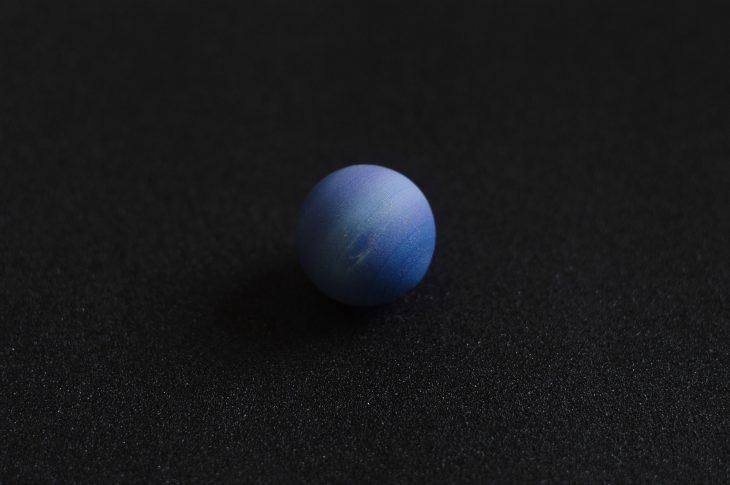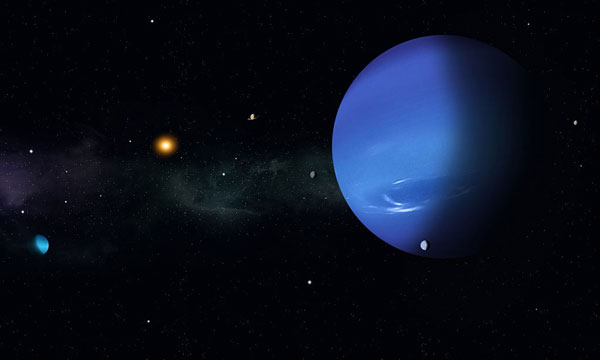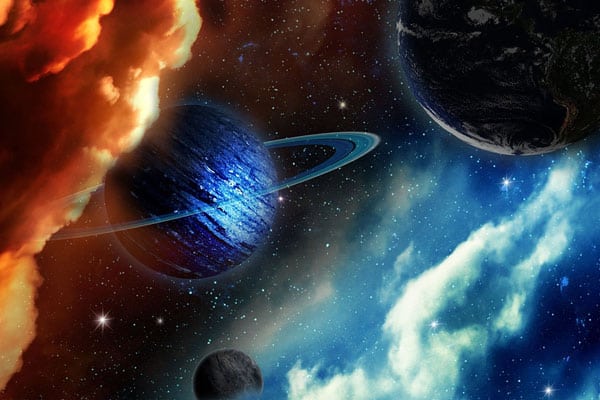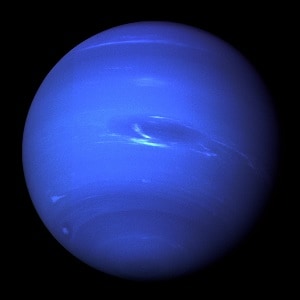
- Diameter: 49,528 km
- Temperature: – 330 °F (- 201 °C)
- Mass: 1E26 kg
- Sun: 2,795,000,000 miles from the Sun
- Position: 8th planet in our solar system
- Discovery: Le Verrier and Galle in 1846
- Atmosphere: 80% hydrogen, 19% helium
- Rings: 5
- Moons: 14
- Color: Azure
- Discovery: Neptune Is the Last Discovered Planet in Our Solar System
- Discovery: Neptune Is the Most Distant Planet in Our Solar System
- Position: Neptune Was Actually Observed Many Times Prior to Official Discovery
- Size: Neptune Is 58 Times Bigger and 17 Times Heavier than Earth
- Time: Neptune’s Year Lasts for Almost 165 Earth Years
- Gravity: A 200 Pound Man Would Weigh 228 Pounds on Neptune
- Distance: Neptune Is Nearly 3 Billion Miles Away from Earth
- Name: Neptune Is Named after the Roman God of the Sea
- Exploration: Only One Probe has Explored Neptune so Far
- Surface: Neptune Has No Solid Surface, Similar to Other Gas Giants
- Wind Speed on Neptune Can Surpass 1,300 Miles per Hour
- Neptune’s Triton Moon is the Only Large Moon with Retrograde Orbit
- Triton, Neptune’s Is One of the Coldest Places in Our Solar System
- Most Languages Use Their Version of Neptune for the Planet’s Name
- Neptune’s Moons Are Named after Roman and Greek Water Gods
- Triton Is the Only Spherically Shaped Moon of Neptune
- Neptune Is the Ruling Planet of Pisces and is Exalted in Leo
- Neptune’s Orbit Is Sometimes Farther from the Sun than Pluto’s
- Neptune Has an Unknown Internal Source of Heat
- Neptune Had a Storm Big Enough to Cover Planet Earth
Neptune Is the Last Discovered Planet in Our Solar System

Neptune facts show that the planet was discovered in 1846, more than 50 years later than the next-to-last discovered planet, Uranus. Neptune was discovered by the French mathematician Urbain Le Verrier and German astronomer Johann Gottfried Galle, and is the only planet to be discovered mathematically first, and not observed in the sky until after.
And how could a planet be mathematically observed? Computations of the Uranus’ orbit, which was the last discovered planet back then, showed some irregularities, and various mathematicians predicted the gravity of a nearby planet to be the cause. Le Verrier was the first of them who was able to predict the almost-exact location of the new planet, and asked astronomer Galle to confirm his calculation by searching for the planet in the sky.
Although Pluto was discovered almost 100 years later, and was believed to be the last planet in our solar system from its discovery in 1930 until 2005, it lost its planetary status when the International Astronomical Union redefined the term “planet”.
Neptune Is the Most Distant Planet in Our Solar System

Neptune is situated approximately 4.5 billion kilometers away from the Sun, which means that it is 30 times more distant from the Sun than planet Earth is. The closest planet to Neptune is Uranus, which is, on average, 11 astronomical units (AU; 1 AU = distance from Earth to the Sun) away from the Sun.
Neptune Was Actually Observed Many Times Prior to Official Discovery
Ever since the telescope was invented in the early 1600s, astronomers explored the sky in order to better understand the universe and our role in it. It was as early as 1613 that Neptune was first observed by Galileo Galilei, but it was not recognized as a new planet. French astronomer Jerome Lalande is supposed to have seen Neptune in 1795, and John Herschel, the son of William Herschel, who discovered Uranus in 1781, is believed to have seen it too in 1830 without knowing what he was looking at…
Neptune Is 58 Times Bigger and 17 Times Heavier than Earth
Its equatorial radius is nearly 4 times bigger than Earth’s, which brings Neptune’s total volume to almost 63,000,000,000,000 km3 and mass to 100,000,000,000,000,000,000,000,000 kg. Although Neptune is 58 times bigger by volume than Earth, it is only 17 times heavier since it has a much lower density of 1.6 g/cm3 (Earth’s density is 5.5 g/cm3).
Neptune’s Year Lasts for Almost 165 Earth Years
Being the most distant planet from the Sun, Neptune’s orbit around the Sun is 30 times longer than Earth’s and its orbital velocity is more than five times slower than Earth’s, so it needs 165 Earth years just to orbit around the Sun once. This means that it needs over 60,000 Earth days to orbit the Sun, but since days on Neptune are shorter than on Earth (at 16 hours), one Neptunian year has almost 90,000 days.
A 200 Pound Man Would Weigh 228 Pounds on Neptune
If you could somehow pay a visit to Neptune, and found a set of scales while you were there, you might be disheartened to discover you weighed quite a bit more than you previously thought. This is due to the simple fact that Neptune’s gravity (11.15 m/s2) is 14% stronger than the Earth’s. Neptune’s gravitational force is the second biggest in our solar system, preceded only by Jupiter’s at almost 25 m/s2.
Neptune Is Nearly 3 Billion Miles Away from Earth
Since both planets constantly move through the solar system, their distance is constantly changing too – at its lowest, the distance between the two is about 2.7 billion miles, and at its highest around 2.9 billion miles, which means that light from Earth would need about four hours to reach Neptune. And how long would a spacecraft from Earth need to reach Neptune? About 10 to 15 years, depending on the selected path…
Neptune Is Named after the Roman God of the Sea

Neptune facts show that before the planet got its name – from the Roman god of the sea, Neptune (equivalent of the Greek Poseidon) – in December 1846, it was known (or suggested to be known) by various other names, including “Le Verrier” and “Le Verrier’s planet” after the man who had discovered it. Other suggestions for the name of the solar system’s newest planet were “the planet exterior to Uranus”, “Janus”, and “Oceanus”.
Only One Probe has Explored Neptune so Far
Considering the vast distance between our planet and Neptune, it is no big surprise that only one spacecraft has so far approached Neptune in the history of mankind. In August 1989, the space probe Voyager 2 flew by Neptune at a distance of approximately 3,000 miles from its north pole, providing us with the majority of data we have on Neptune to this day.
It took Voyager 2 almost 12 years to reach Neptune after being launched from Earth, but the probe was delayed along the way on various occasions, visiting the planets of Jupiter, Saturn and Uranus too.
Neptune Has No Solid Surface, Similar to Other Gas Giants
As with the other gas giants of our solar system (Jupiter, Saturn, Uranus), Neptune has no definite surface layer, but only gas transiting into a slushy water and ice layer. The blue color that can be seen on photographs of the planet is actually not its surface, but the top of the planet’s clouds. Neptune appears a very bright azure blue in images, very different to the much paler blue of Uranus.
Wind Speed on Neptune Can Surpass 1,300 Miles per Hour
Even the Earth’s very strongest storm winds rarely exceed 300 mph, so it is clear that the powerful winds on Neptune would make life as we know it on Earth very difficult. In fact, it’s impossible for us to imagine the strength of these fearsome winds. These violent windspeeds are mostly a consequence of the very hot interior of the planet clashing with the vast coldness of space.
Neptune’s Triton Moon is the Only Large Moon with Retrograde Orbit
Neptune facts reveal that its largest moon Triton orbits Neptune in the opposite direction of the planet’s rotation – the only large moon in our solar system that does this. Furthermore, Triton’s orbit around Neptune is nearly a perfect circle with its eccentricity (a measure determining deviation from a perfect circular orbit) being only 0.000016 (for comparison: the Moon’s eccentricity on the orbit around Earth is 0.0549 and the Earth’s eccentricity on its orbit around the Sun is 0.0167).
Triton, Neptune’s Is One of the Coldest Places in Our Solar System
Neptune facts reveal that not only is Neptune is one of the coldest planets in the solar system, but that its biggest moon Triton is even colder – the temperature on its surface can dip as low as almost – 400 °F (- 240 °C). This large, frozen moon is covered with violent geysers that spew nitrogen gas up into the air and several miles into space.
Most Languages Use Their Version of Neptune for the Planet’s Name
One of the most interesting Neptune facts reveals that most languages of the world use their own version of the word “Neptune” for the planet’s name. For example, the people of China, who obviously have no connection with ancient European deities, use the name “Sea King Star” for Neptune, since Neptune is the god of the sea. The Greeks use their own counterpart of the Roman god Neptune – to them, this azure blue planet is called Poseidon.
Neptune’s Moons Are Named after Roman and Greek Water Gods

Since Neptune got its name from the god of the sea, it seems only natural that its satellites are named after lesser deities connected with water. Neptune’s biggest moon Triton is named after the son of Poseidon (the Greek equivalent of Neptune), moons Naiad and Nereid are named after two types of Greek water and sea nymphs, and Proteus, the second biggest of Neptune’s satellites, is named after another one of Poseidon’s sons.
Triton Is the Only Spherically Shaped Moon of Neptune
Neptune facts reveal that all the other 12 moons of the planet are irregularly shaped, while Triton alone is spherically shaped. Why is Triton different to the others? Simply because the other moons are all too small for their surface to have collapsed into a spheroid, making Triton unique among Neptune’s moons.
Neptune Is the Ruling Planet of Pisces and is Exalted in Leo
For those who trust in the art of astrology, Neptune is a sign of sensitivity, idealism, compassion and sometimes also illusion, deception or confusion. It symbolizes the spirit being pierced by matter. Also sometimes known as the Planet of Illusion, Neptune is considered very important by many astrology practitioners. It is believed to help dissolve barriers and raise people up to experience mystical phenomena.
Neptune’s Orbit Is Sometimes Farther from the Sun than Pluto’s
Pluto is nowadays considered to be only a dwarf planet, so there is no doubt which is the outmost planet of our solar system. But even when Pluto was still considered a planet, Neptune occasionally held the position of the 9th planet in our solar system – simply because it sometimes orbits farther away from the Sun than Pluto does (the last time this occurred was between the years of 1979 and 1999).
Neptune Has an Unknown Internal Source of Heat
Being 30 astronomical units (1 AU = distance of Earth from the Sun) away from the Sun, Neptune receives only about 0.1% of the solar energy that reaches the Earth. However, it radiates 2.6 times more energy than it receives from the Sun, which means that it has its own internal heat source. Unfortunately, we still don’t know what or where this is, or how it provides so much heat…
Neptune Had a Storm Big Enough to Cover Planet Earth
Neptune facts show that Neptune was once ravaged by a mighty storm that could cover the Earth’s entire surface. When Voyager 2 visited Neptune in 1989, it found a large storm that moved with a great speed of 750 mph westward through the southern hemisphere. When scientists tried to photograph the storm, named Great Dark Spot, again in 1994 with the Hubble Space Telescope, it was gone, but a similar storm had appeared on the northern hemisphere.
Neptune Facts— Facts about Neptune Summary
 Neptune is the farthest planet from the Sun in our solar system, and the third largest planet by mass and fourth largest by diameter. Named after the Roman god of the sea, Neptune is the last discovered planet. Its climate is not fitting for life as we know it on Earth due to low temperatures and violent storms with strong winds, and its surface is not solid, but made out of gas, similar to the other three gas giants in the solar system. One day on Neptune lasts for 16 hours, and one year for almost 165 Earth years. It is also the only planet that was mathematically discovered prior to being actually observed up in the sky.
Neptune is the farthest planet from the Sun in our solar system, and the third largest planet by mass and fourth largest by diameter. Named after the Roman god of the sea, Neptune is the last discovered planet. Its climate is not fitting for life as we know it on Earth due to low temperatures and violent storms with strong winds, and its surface is not solid, but made out of gas, similar to the other three gas giants in the solar system. One day on Neptune lasts for 16 hours, and one year for almost 165 Earth years. It is also the only planet that was mathematically discovered prior to being actually observed up in the sky.
Was this page helpful?
Our commitment to delivering trustworthy and engaging content is at the heart of what we do. Each fact on our site is contributed by real users like you, bringing a wealth of diverse insights and information. To ensure the highest standards of accuracy and reliability, our dedicated editors meticulously review each submission. This process guarantees that the facts we share are not only fascinating but also credible. Trust in our commitment to quality and authenticity as you explore and learn with us.
